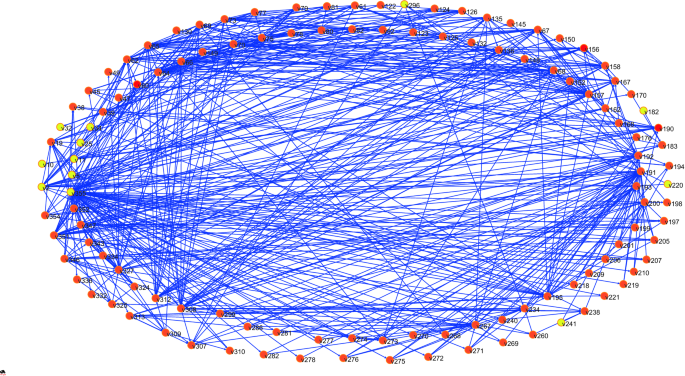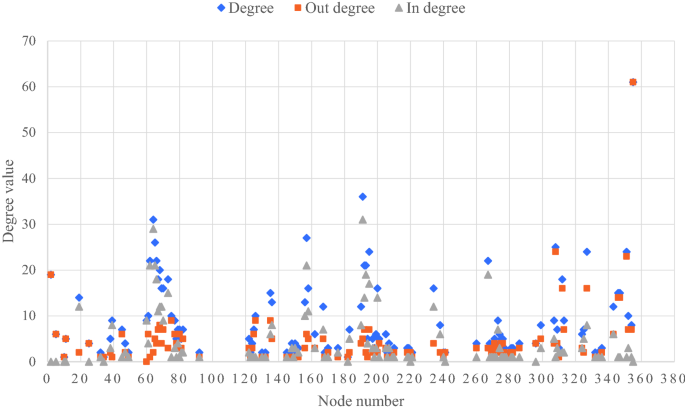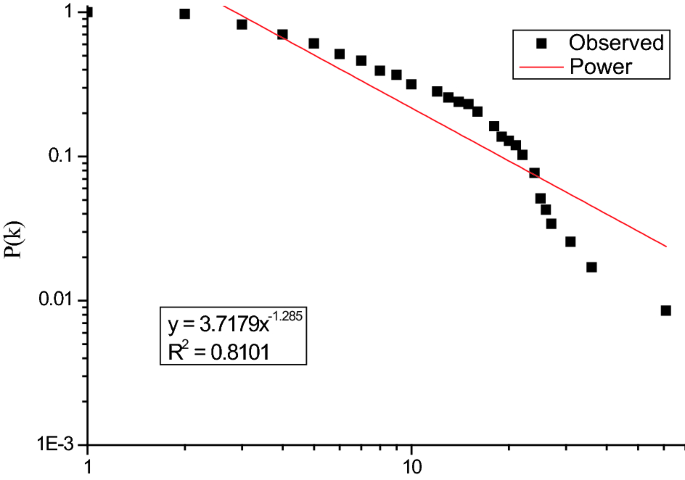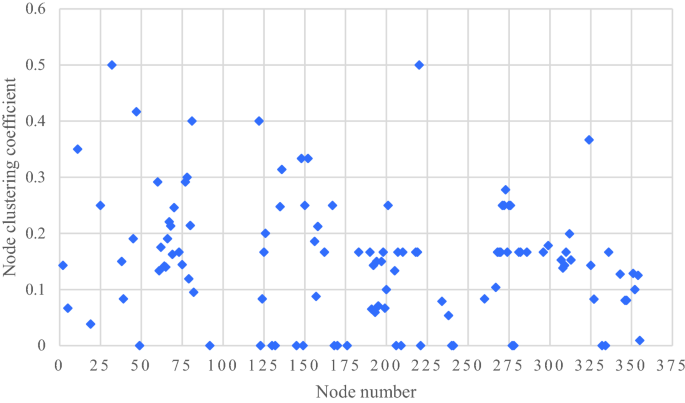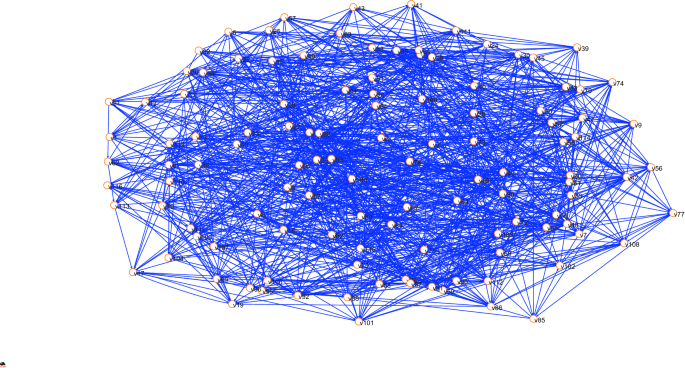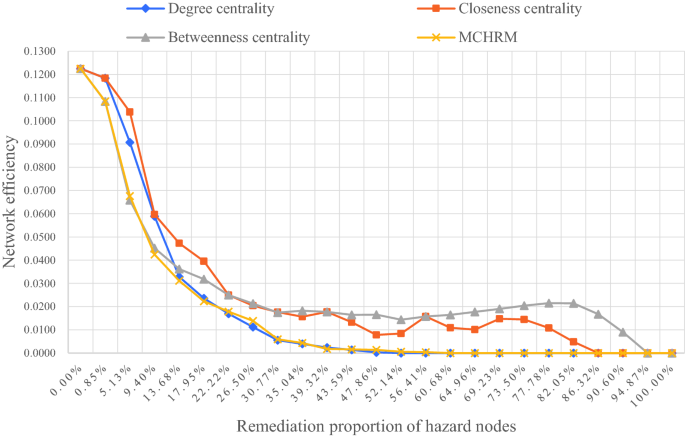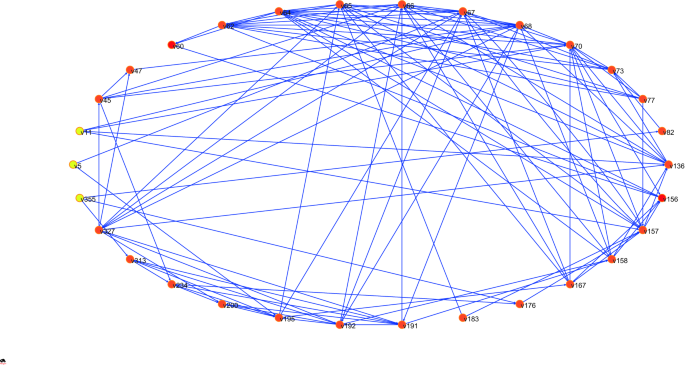The paper takes Feijão Dam I in Brazil as a case. The crest elevation of Dam I is 942 m, the maximum height is 86 m, and the dam crest length is 720 m. The height of each sub-dam varies from 5 to 18 m. The slope of the upstream and downstream slopes is between 1:2.5 and 1:1.5, and the other slopes of the dam body generally adopt a slope of 1:2. After 2013, Dam I stopped the construction of tailings dam. Later, in July 2016, the stockpiling of tailings was stopped and the tailings pond was closed. More information about Dam I can be found in Report of the Expert Panel on the Technical Causes of the Failure of Dam I36.
Identification of hazards and the relationship between Hazards
A total of 117 hazards and 535 relationships are obtained by the THIF method, as shown in “Appendix A”32. In “Appendix A”, the first column indicates the categories of hazards, including four categories: environment factor, personnel factor, material factor, and management factor. The second column indicates the number (ID) of the hazards in the third column. The fourth column indicates the number of the hazards caused by the hazard in the third column. For example, the hazard named ‘heavy rainfall’ in the second row of the third column is numbered 5, which belongs to the environment factor. Through the THIF method, we can get the hazards that may be caused by the ‘heavy rainfall’. These hazards are numbered 19, 67, 69, 150, 193 and 19.
Propagation network of Dam I failure risk
This section uses hazards of Dam I and the relationship between the hazards in “Appendix A” to construct the adjacency matrix, and then import it into Pajek software to construct the propagation network of Dam I failure risk (I-FRPN), as shown in Fig. 1.
Degree and degree distribution
The degree value of each node in I-FRPN can be obtained through Pajek complex network software as shown in Fig. 2. The average degree of the I-FRPN is 9.15, and the network density is 0.04, indicating that a hazard node is directly related to 9.15 hazard nodes on average, but the overall density of the I-FRPN is not large.
It can be seen from Fig. 2 that among the top 10 hazards, 355 (Insufficient experience in personnel or organization qualification problems) is the hazard node with the largest degree value in the I-FRPN, which directly affects 61 hazards. It shows that if the personnel and organization do not have sufficient experience or do not meet the corresponding qualification requirements, the tailings dam will always be threatened throughout its life cycle. 191 (Fracture of drainage structure) is directly related to 36 hazards, which is the second largest hazard in the degree value. It is classified as a material factor among the four influencing factors. The degree values of 62 (partial landslide and collapse of the dam), 64 (Dam instability), 65 (Dam deformation), 157 (Filter failure), 195 (Rapid rise of pond water level) and 327 (Safety monitoring facilities cannot fully reflect the operating status of the tailings pond) are respectively 22, 31, 26, 27, 24 and 24. These hazards belong to the material factor together with the hazard 191, and account for 70% of the top 10 hazards, highlighting the fact that the material factor plays a leading role in tailings dam safety management.
Hazard 308 (Closure design not in accordance with regulations) has a degree value of 25, which belongs to the same personnel factor as hazard 355, and these hazards are indirect factors that lead to dam break. 351 (Improper maintenance) is directly related to 24 hazards, which is the management factor, indicating that management plays an important role in the safety management of tailings dams.
From the point of view of out degree, the values of hazards 355 (Insufficient experience in personnel or organization qualification problems), 308 (Closure design not in accordance with regulations), 351 (Improper maintenance), 2 (Flood) and 312 (Dam body remediation does not meet the requirements) are respectively 61, 24, 23, 19, and 16, which are the five nodes with the largest out-degree value, indicating that personnel factors, management factors, and environmental factors are more likely to cause other hazards. 191 (fracture of drainage structure), 62 (partial landslide and collapse of dam), 64 (dam instability), 65 (dam deformation), and 157 (failure of water filter body) are the 5 hazards with the highest in-degree value, and in-degree values are respectively 31, 29, 21, 21, and 21. These hazards all are material factors, indicating that material factors are prone to form armed hazards under the influence of dormant hazards.
Cumulative degree distribution of the I-FRPN is shown in Fig. 3. The cumulative degree distribution presents a power-law distribution that has the approximate fit (Pleft(kright)={3.7179x}^{-1.285}) (({R}^{2}=0.8101)). The above result deviates from the power-law nature for lager k, which indicates that the I-FRPN has scale-free property18,37. It means that a few hub nodes play a dominant role in the I-FRPN. If we can find these key nodes, the spread of risk can be slowed down or even blocked, thus preventing the occurrence of dam break. The degree studied in this section is an important indicator for judging the importance of network nodes. In addition, there are also indicators such as betweenness centrality and closeness centrality that are also commonly used to measure the importance of nodes. In the next section, we will conduct more analysis on this aspect.
Network diameter and average path length
The network diameter, also known as the maximum path length of a network, represents the largest step length between two nodes in the network34. After calculation, the network diameter of the I-FRPN is 8, which means that a hazard node can affect any node in the network only after a maximum of 8 steps. The most distant node pairs of the network are v32 and v150 or v7 and v45. Compared with some accident networks studied in the past15,37,38, the diameter of I-FRPN is larger, and the evolution path of the risk is complicated.
The characteristic path length is also called the average path length. After calculation, the average path length of the I-FRPN is 2.81, indicating that it takes less than 3 steps on average to transfer the risk of dam break from one hazard to another hazard. The above results show that the characteristic path length of the I-FRPN is small, and the risk of dam break can be spread quickly on the network. If no corresponding measures are taken, the emergence of a serious hazard may cause a tailings dam break in a relatively short time.
Clustering coefficient and small-world property
The clustering coefficient of the I-FRPN refers to the degree of interconnection between adjacent nodes of a hazard node in the network37. That is to say, there is no clustering coefficient for nodes with a degree value of 1. In this paper, the average clustering coefficient of the I-FRPN is calculated by Pajek software as 0.15. After excluding the nodes with a degree of 1, the clustering coefficients of the hazard nodes in the network are obtained, as shown in Fig. 4. It can be seen from the figure that the clustering coefficient of the hazard node in the I-FRPN is between 0 and 0.5. The clustering coefficients of hazard 32 (Insufficient tank length) and 220 (The maximum flow rate of flood control structure design is greater than the allowable flow rate of building materials) are both 0.5, which are the nodes with the largest clustering coefficient, indicating that the adjacent hazards of the hazard 32 and 220 have a strong correlation and show strong clustering.
Small-world networks usually have large clustering coefficients and small characteristic path lengths34. In order to judge whether the clustering coefficient of the I-FRPN meets the requirements of the small world, this paper constructs a random network with the same number of nodes and the same degree value as the I-FRPN, and calculates the clustering coefficient to be 0.08, which is smaller than the clustering coefficient of the I-FRPN (0.15). The equal-sized dam failure risk random network is called the mode of WW, as shown in Fig. 5. Combined with the characteristic path length of the I-FRPN is only 2.81, it can be concluded that the I-FRPN has small-world property. In other words, the break accident for Dam I has the characteristics of multi-factor coupling and short disaster path.
Key hazards nodes in the I-FRPN
The paper first treats(deletes) the node with the largest index value and calculates the network efficiency, and then calculates the network efficiency after every 5 hazard nodes are treated. Figure 6 shows the changes of the network efficiency under the different hazard remediation methods.
In Fig. 6, it can be found that the preferential treatment of nodes with large betweenness centrality can achieve better results in the early stage (low deleting proportion). In other words, when the remediation proportion of hazard nodes is small, the risk propagation speed can be reduced more quickly by the betweenness centrality. However, when the proportion of hazard remediation reaches 13.68%, the hazard node with a higher degree value will have a better effect of reducing risk spread.
It can be seen from Fig. 6 that the MCHRM performs better than the other three commonly used methods, whether in the early stage of the hazard node remediation or in other stages. In addition, we can also find that all four methods show that when the proportion of node remediation reaches about 30%, the decline in network efficiency tends to slow down significantly. Further increasing the proportion of node remediation will not significantly reduce the propagation efficiency of the network. In other words, when we are in the process of hazard remediation of tailings dams, if we give priority to the top 30% of hazard nodes determined by the MCHRM, we can use the vulnerability of the network to reduce network efficiency more quickly. In this paper, these hazard nodes that can quickly reduce the propagation efficiency of the I-FRPN are called key hazards of Dam I failure, and the relationships between these key hazards are called the key propagation paths.
Failure process of Feijão Dam I
Since the weights between nodes in I-FRPN are assumed to be equal, only relying on network centrality analysis may miss the key hazards of Dam I failure. In order to overcome the problem, the paper has expanded the selection range of key hazards and set the key hazards as the top 45% of the index value. The I-FRPN has a total of 117 hazard nodes, and the top 45% of the index value includes 53 nodes. The expanded key hazards determined by MCHRM are shown in Table 1. The first column of Table 1 is the serial number of the key hazards, indicating the importance of the hazards. The third column is the name of the hazard to be studied, the second column is the number (ID) of the hazard, the sixth column is the level of the corresponding hazard node, and the fourth and fifth columns are the degree value and the betweenness centrality of the hazard node.
By consulting the monitoring data, daily inspection results and safety evaluation information of each hazard before the failure of Dam I, the level of each hazard is obtained according to the grading standards of hazard indicators in “Appendix B”, as shown in Table 1.
By excluding the hazard nodes of level 1 in the normal state, we can determine that there are 30 key hazards in the failure accident of Feijão Dam I. Combining the evolution relationship among the hazards based on evidence in “Appendix A”, we can obtain the 240 propagation paths between key hazards. The key hazards and propagation paths of Dam I failure are shown in Fig. 7.



